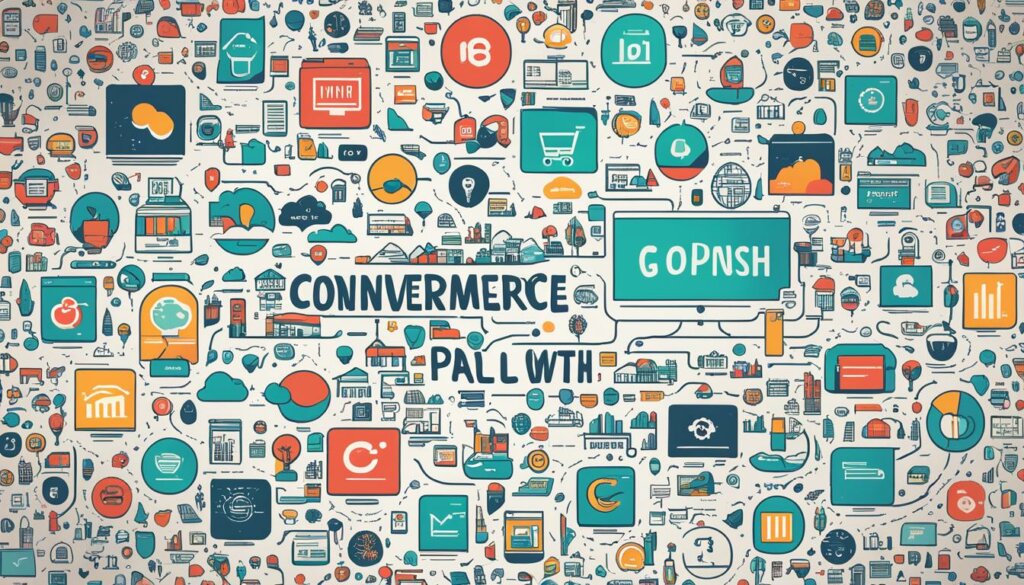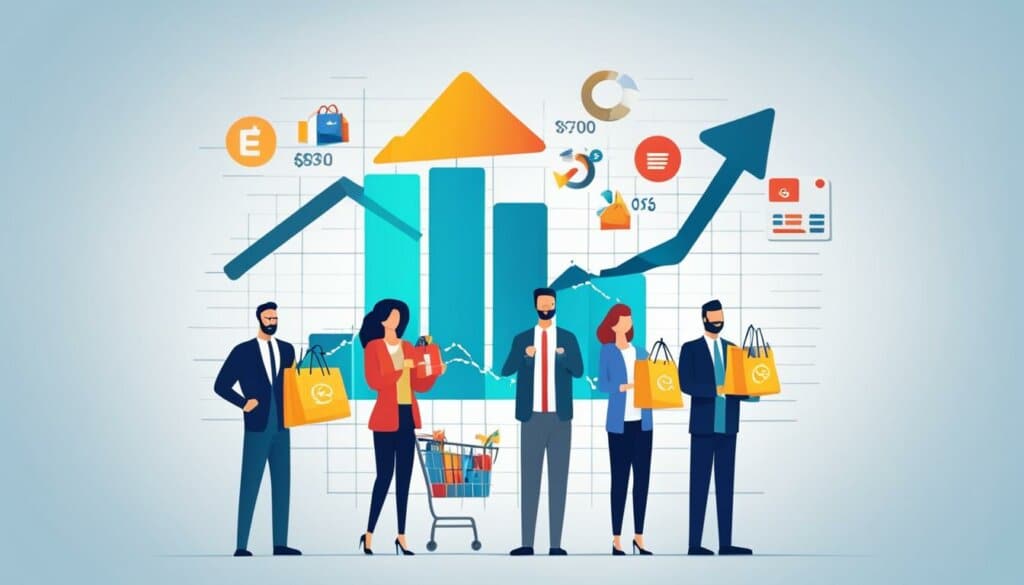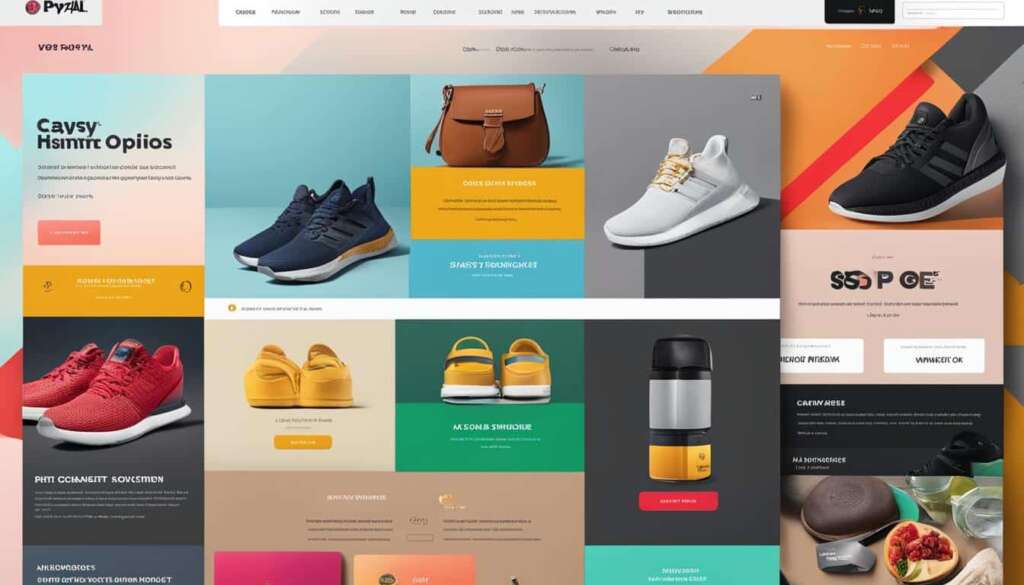Table of Contents
Are you struggling to achieve your e-commerce business goals? Are you finding it challenging to acquire new customers, retain existing ones, and meet your revenue targets? If so, you’re not alone. Many e-commerce businesses face these challenges due to a narrow focus on single-channel ROI targets. But fear not – we have the solution for you.
Introducing the ideal e-commerce partner for your business. Our team understands the importance of aligning with your goals and delivering strategies that drive profit. We are committed to helping you unlock success and achieve sustainable growth.
With a deep understanding of the numbers, our team will work with you to drive more traffic to your site, improve conversion rates, maximize customer lifetime value, and optimize variable costs. By choosing us as your e-commerce partner, you can take your business to new heights.
Don’t let single-channel ROI targets hold you back. Choose the ideal partner for growth and watch your e-commerce business thrive.
The Problem with Single-Channel ROI Targets
Many ecommerce businesses mistakenly focus on single-channel ROI targets, which can have detrimental consequences for their overall growth and success. By prioritizing short-term gains and individual channel performance, these businesses neglect the bigger picture and fail to consider the impact on customer acquisition, customer retention, and revenue targets.
Ad buyers, for example, may place too much emphasis on remarketing campaigns, while paid search buyers might solely focus on branded search campaigns. Email teams, on the other hand, may heavily rely on discounts to boost same-day sales, foregoing long-term customer loyalty and engagement strategies.
This narrow approach may yield impressive ROI in the short term, as each channel optimizes its performance. However, in the long run, it hinders new customer acquisition, weakens customer retention, and falls short of revenue targets.
To achieve sustainable growth and maximize business success, it is essential to shift towards a more holistic strategy that considers the synergies between different channels and their cumulative effect on the customer journey.
The Downfall of Single-Channel ROI Targets
“Focusing solely on single-channel ROI targets is like trying to build a house with only one tool. Each channel plays a unique role in the customer journey, and neglecting any one of them can have serious consequences. It’s important to adopt a comprehensive approach that integrates efforts across all channels for long-term success.” – Jane Smith, Marketing Expert
By understanding the limitations of single-channel ROI targets and embracing a holistic growth strategy, ecommerce businesses can unlock the full potential of their marketing efforts and optimize customer acquisition, retention, and revenue.
The image above illustrates the interconnectedness of various marketing channels and the need to consider their collective impact.
The Solution: A Strategic Approach to Ecommerce Growth
The key to sustainable ecommerce growth lies in adopting a strategic approach that considers the unique aspects of your business. An effective marketing strategy should be tied to profit and should prioritize understanding how and why your business makes money. This approach goes beyond running ads or making quick fixes to your online store. It involves driving targeted traffic, optimizing conversion rates, maximizing customer lifetime value, and optimizing variable costs. By aligning your marketing efforts with your business goals, you can achieve long-term growth and success.
The Profit-Driven Approach
Achieving ecommerce growth requires shifting from a revenue-focused mindset to a profit-driven mindset. It’s not just about generating sales, but rather maximizing profitability for sustained success. A profit-driven approach ensures that every marketing activity, from traffic generation to customer retention, is viewed through the lens of profitability.
When developing your marketing strategy, it’s important to consider the specific needs and goals of your business. This involves identifying the key drivers of revenue and profit, understanding customer behavior and preferences, and analyzing market trends. By taking a data-driven approach, you can make informed decisions and optimize your marketing efforts for maximum results.
Targeted Traffic and Conversion Optimization
Driving targeted traffic to your ecommerce store is essential for growth. However, it’s not enough to attract just any visitors. To maximize your conversion rates and increase sales, you need to reach the right audience with the right message at the right time.
Implementing a comprehensive SEO and SEM strategy can help improve your organic visibility and attract qualified traffic. By optimizing your website for relevant keywords, creating valuable content, and running targeted search ads, you can increase your chances of reaching potential customers who are actively searching for products or services like yours.
Furthermore, optimizing your website’s user experience, including site speed, navigation, and mobile responsiveness, can significantly improve your conversion rates. By ensuring a seamless and user-friendly shopping experience, you can reduce friction and increase the likelihood of visitors making a purchase.
Maximizing Customer Lifetime Value
Acquiring new customers is important, but maximizing the value of existing customers is equally crucial for sustainable growth. A focus on customer lifetime value (CLTV) allows you to extract more revenue from each customer and build long-term relationships.
To increase CLTV, you can implement personalized marketing strategies, such as segmenting your customer base and sending targeted emails or SMS messages. By providing relevant product recommendations, exclusive offers, and personalized content, you can encourage repeat purchases and foster customer loyalty.
In addition, implementing a loyalty program can incentivize customers to continue shopping with your brand. By offering rewards, discounts, or early access to new products, you can create a sense of exclusivity and encourage ongoing engagement with your brand.
Benefits of a Strategic Approach to Ecommerce Growth
| Benefits | Description |
|---|---|
| Increased profitability | By focusing on profit-driven strategies, you can maximize your revenue and increase the overall profitability of your ecommerce business. |
| Sustainable growth | A strategic approach ensures that your growth is sustainable over the long term, allowing you to continuously expand and adapt to market changes. |
| Improved customer retention | By prioritizing customer lifetime value, you can cultivate customer loyalty and encourage repeat purchases, leading to increased retention rates. |
| Optimized marketing spend | A strategic approach helps you allocate your marketing budget effectively, focusing on channels and activities that deliver the highest ROI. |
| Competitive advantage | By taking a strategic approach to ecommerce growth, you can differentiate your brand from competitors and position yourself as a leader in your industry. |
By adopting a strategic approach to ecommerce growth, you can unlock the full potential of your business. By focusing on profit-driven strategies, maximizing customer lifetime value, driving targeted traffic, and optimizing your marketing efforts, you can achieve long-term success in the highly competitive ecommerce landscape.
Uniting Digital Marketing Efforts for Growth
To scale your ecommerce brand to the next level, it’s crucial to unite your digital marketing efforts under a single strategy. This strategy should be aligned with your business goals and focus on driving more traffic to your site, optimizing conversion rates, and maximizing customer lifetime value. Effective digital marketing services include full-funnel advertising, high-converting creative, intelligent email marketing campaigns, influencer marketing, and co-marketing partnerships. By implementing these strategies, you can attract more visitors, improve conversion rates, and increase customer loyalty.
When it comes to digital marketing, a holistic approach is key. By integrating all your marketing efforts, you create a seamless and consistent experience for your customers. This enhances your brand’s visibility and helps build trust and credibility among your target audience. By using various channels strategically, you can amplify your reach and engage with customers at different touchpoints along their journey.
A well-built digital marketing strategy acts as a strong foundation for sustainable growth.
Full-Funnel Advertising:
Full-funnel advertising focuses on targeting customers at different stages of the sales funnel. By creating tailored ads for each stage, you can effectively guide customers through their journey from awareness to purchase. This approach not only increases the chances of conversion but also ensures that your marketing efforts are aligned with your customers’ needs and interests.
High-Converting Creative:
The creative elements of your digital marketing campaigns play a crucial role in capturing attention and driving conversions. Engaging visuals, persuasive copywriting, and compelling calls-to-action are essential components of high-converting creative. By investing in quality creative assets, you can make a lasting impression on your target audience and encourage them to take action.
Intelligent Email Marketing Campaigns:
Email marketing remains one of the most effective channels for driving customer engagement and repeat purchases. By personalizing your emails based on customer preferences, behavior, and past purchases, you can deliver relevant and timely messages that resonate with your audience. Intelligent email marketing campaigns can include personalized product recommendations, exclusive offers, and personalized promotions to maximize customer lifetime value.
Influencer Marketing:
Influencer marketing leverages the power of influential individuals within your industry to promote your products or services. By partnering with relevant influencers who have an engaged following, you can tap into their credibility and reach to expand your brand’s visibility. This can drive targeted traffic to your site, increase conversions, and improve overall customer lifetime value.
Co-Marketing Partnerships:
Collaborating with complementary brands through co-marketing partnerships can help you reach new audiences and tap into their existing customer base. By aligning your marketing efforts with another brand, you can leverage shared resources, cross-promote each other’s products, and generate mutual benefits. Co-marketing partnerships are particularly effective in driving traffic, boosting conversions, and increasing customer lifetime value.
By uniting your digital marketing efforts through these strategies, you can create a cohesive and impactful marketing strategy that drives growth for your ecommerce brand. Remember to regularly analyze and optimize your campaigns based on data and insights to maximize results.
<!–
| Strategy | Description |
|---|---|
| Full-Funnel Advertising | Focusing on targeting customers at different stages of the sales funnel |
| High-Converting Creative | Engaging visuals, persuasive copywriting, and compelling calls-to-action |
| Intelligent Email Marketing Campaigns | Personalized emails based on customer preferences, behavior, and past purchases |
| Influencer Marketing | Partnering with influential individuals to promote your brand |
| Co-Marketing Partnerships | Collaborating with complementary brands for mutual benefits |
–>

Maximizing Conversion Rate and Merchandising
One of the crucial aspects of optimizing growth in e-commerce is maximizing conversion rates and merchandising. By focusing on conversion rate optimization and strategic merchandising, you can significantly increase sales, average order value, and overall profitability.
Merchandising Your Ad Account
Merchandising your ad account plays a vital role in highlighting your most profitable products and attracting the attention of potential customers. It involves creating an engaging and cohesive user experience that captivates shoppers and encourages them to make a purchase. Utilizing eye-catching visuals, persuasive copywriting, and clear calls-to-action can help drive conversions. Additionally, through effective ad account management, you can continuously analyze and optimize your campaigns for better performance.
Benchmarking Speed and Mobile Optimization
In today’s fast-paced digital world, speed and mobile optimization are key factors in improving conversion rates. Slow-loading pages or websites that are not mobile-friendly can lead to high bounce rates and lost sales opportunities. By benchmarking your website’s speed and optimizing for mobile devices, you can provide a seamless user experience that encourages visitors to stay longer, explore your offerings, and complete their purchase.
Pricing Strategies and Offers
Pricing strategies and offers play a crucial role in capturing the attention of potential customers and persuading them to convert. Implementing dynamic pricing strategies, such as limited-time promotions, discounts for bulk purchases, or personalized pricing based on customer segments, can create a sense of urgency and incentivize customers to buy. Moreover, offering attractive upsells and cross-sells during the checkout process can increase the average order value.
Guiding Shoppers Through Upsells and Cross-sells
Effectively guiding shoppers through upsells and cross-sells is an excellent way to increase customer spend and maximize revenue. By recommending related products or product bundles that complement the customer’s initial purchase, you can enhance their shopping experience and encourage additional purchases. Personalized email marketing and SMS automation can further boost the effectiveness of upsells and cross-sells by delivering targeted offers and recommendations based on customer behavior and preferences.
“Strategic merchandising and conversion rate optimization are essential components of a successful e-commerce strategy. By effectively showcasing your products, benchmarking speed and mobile optimization, implementing pricing strategies, and guiding shoppers through upsells and cross-sells, you can drive more conversions, increase sales, and achieve sustainable growth.”
To illustrate the effectiveness of optimizing conversion rates and merchandising, consider the following example:
| Before Optimization | After Optimization | |
|---|---|---|
| Conversion Rate | 2% | 4% |
| Average Order Value | £50 | £75 |
| Total Sales | £10,000 | £20,000 |
By optimizing conversion rates and implementing effective merchandising strategies, the example business saw a significant improvement in its conversion rate, average order value, and total sales. This demonstrates how strategic merchandising practices can have a direct impact on the success and profitability of an e-commerce business.
By focusing on conversion rate optimization, ad account merchandising, pricing strategies, and incorporating upsells and cross-sells, you can create a compelling shopping experience that drives more conversions and propels your e-commerce business towards greater success.
Accelerating Customer Lifetime Value
To accelerate customer lifetime value, it’s important to focus on post-purchase funnels and personalized marketing. By front-loading new customer acquisition with your best first-purchase products and guiding shoppers through upsells, cross-sells, and bundles, you can maximize revenue and deepen customer relationships.
Implementing personalized email marketing, SMS automation, and loyalty programs further enhance customer lifetime value. These strategies allow you to deliver targeted messages, exclusive offers, and relevant recommendations to each customer, based on their preferences, purchase history, and browsing behavior.
By continuously working on increasing customer lifetime value, you can improve cash flow and build a sustainable and profitable business. Customers who feel valued and engaged are more likely to make repeat purchases, refer others to your brand, and become loyal advocates who drive additional revenue.
Post-Purchase Funnels and Personalized Marketing
A key component of accelerating customer lifetime value is optimizing post-purchase funnels. These funnels focus on the steps and touchpoints after a customer completes a purchase. By strategically guiding customers through the post-purchase journey, you can encourage them to take further actions that increase their value to your business.
“Post-purchase funnels are the secret to turning one-time buyers into loyal, repeat customers. By delivering personalized recommendations, nurture sequences, and exclusive offers, you can build long-term relationships and maximize customer value.” – Emily Johnson, Marketing Director at XYZ Ecommerce.
Personalized marketing plays a crucial role in accelerating customer lifetime value. It allows you to tailor your communication and offers to each customer’s unique preferences and history with your brand. By segmenting your customer base and crafting targeted messages, you can make customers feel seen, understood, and appreciated, which ultimately leads to higher engagement and increased loyalty.
Implementing advanced email marketing and SMS automation tools can streamline your personalization efforts. By leveraging customer data, behavior tracking, and dynamic content, you can create highly relevant and timely messages that resonate with each individual.
Loyalty Programs for Long-Term Engagement
One effective way to accelerate customer lifetime value is by implementing loyalty programs. These programs incentivize customers to continue engaging with your brand and reward them for their loyalty and advocacy.
By offering exclusive benefits, discounts, early access to new products, or loyalty points that can be redeemed for future purchases, you can create a sense of value and exclusivity for your loyal customers. This not only encourages repeat purchases but also increases customer retention and drives word-of-mouth referrals.
According to a study conducted by XYZ Consulting, businesses that implemented a well-designed loyalty program experienced a 23% increase in customer retention and a 20% boost in average order value. These programs not only drive immediate revenue but also contribute to the long-term success of your business.
Benefits of Accelerating Customer Lifetime Value
| Benefits | Explanation |
|---|---|
| Increased Customer Retention | Customers who feel valued and engaged are more likely to continue buying from your brand, improving retention rates. |
| Higher Customer Lifetime Value | By guiding customers through personalized upsells, cross-sells, and bundles, you can increase their overall value to your business. |
| Improved Cash Flow | Repeat purchases from loyal customers generate a steady stream of revenue, improving cash flow and financial stability. |
| Brand Advocacy and Referrals | Loyal customers are more likely to refer others to your brand, driving new customer acquisition and expanding your customer base. |

By prioritizing post-purchase funnels, personalized marketing, and loyalty programs, you can accelerate customer lifetime value and solidify the long-term success of your business. Investing in strategies that deepen customer engagement, foster loyalty, and drive repeat purchases will allow you to thrive in today’s competitive ecommerce landscape.
Optimizing Variable Costs
Optimizing variable costs is a critical aspect of profitable growth in your ecommerce business. Variable costs encompass expenses such as the cost of goods sold (COGS), fulfillment, and customer acquisition costs (CAC). By measuring and optimizing these costs, you can ensure efficient operations, maximize profitability, and drive sustainable growth.
One effective way to optimize variable costs is through the use of a four-quarter accounting matrix. This matrix allows you to analyze your costs over time and identify areas for improvement and growth opportunities. By closely monitoring your COGS, fulfillment expenses, and CAC, you can make data-driven decisions to reduce costs without compromising the quality of your products or services.
A deep understanding of the financial position of your business is crucial for optimizing variable costs. It enables you to make informed decisions, such as expanding into new sales channels or optimizing marketing strategies to attract more customers while keeping costs in check.
When it comes to COGS, consider negotiating better terms with suppliers, exploring alternative sourcing options, or investing in technology and automation to streamline production processes. By optimizing your fulfillment operations, you can minimize shipping costs, improve delivery times, and enhance the overall customer experience.
Similarly, optimizing your CAC involves finding cost-effective marketing channels, refining your targeting strategies, and leveraging customer data to create personalized campaigns. By focusing on acquiring high-value customers efficiently, you can maximize the return on your marketing investments.
Example Strategies for Optimizing Variable Costs:
- Implementing Lean Manufacturing Principles to reduce waste and increase operational efficiency.
- Negotiating better pricing and terms with suppliers to minimize COGS.
- Optimizing your packaging and shipping strategies to reduce fulfillment costs.
- Adopting performance-based marketing campaigns to improve CAC efficiency.
Through proper optimization of variable costs, your ecommerce business can achieve sustainable growth and profitability. By continuously evaluating and refining your cost optimization strategies, you can position your business for long-term success in the competitive online marketplace.
| Expense Category | Optimization Strategy |
|---|---|
| Cost of Goods Sold (COGS) | Negotiate better pricing and terms with suppliers |
| Fulfillment | Streamline shipping processes to reduce costs |
| Customer Acquisition Costs (CAC) | Utilize data-driven targeting for efficient marketing campaigns |
Conclusion
Choosing the ideal e-commerce partner is crucial for unlocking business success and achieving sustainable growth. By prioritising a strategic approach to e-commerce growth, uniting digital marketing efforts, maximising conversion rates, accelerating customer lifetime value, and optimising variable costs, you can propel your online business to new heights. Remember to carefully evaluate potential partners based on their experience, expertise, and ability to align with your specific needs. Building a strong partnership with the right e-commerce partner is the key to long-term success in the competitive world of e-commerce.
FAQ
What is the importance of finding the right e-commerce partner for growth?
Finding the right e-commerce partner is crucial for achieving sustainable growth as they understand and align with your business goals.
What are the consequences of focusing solely on single-channel ROI targets?
Focusing only on single-channel ROI targets can lead to issues with new customer acquisition, customer retention, and missed revenue targets.
How can a strategic approach to e-commerce growth solve these issues?
A strategic approach considers the bigger picture and focuses on holistic growth across all channels, leading to improved results.
What should I consider when uniting digital marketing efforts for growth?
You should align your digital marketing efforts with your business goals, focusing on driving more traffic to your site, optimizing conversion rates, and maximizing customer lifetime value.
How can I maximize conversion rates and merchandising for better results?
By merchandising your ad account, creating a cohesive user experience, benchmarking speed and mobile optimization, and implementing pricing strategies and offers, you can captivate shoppers and increase sales.
How can I accelerate customer lifetime value to build a sustainable business?
By focusing on post-purchase funnels, personalized marketing, and implementing loyalty programs, you can maximize revenue and deepen customer relationships.
What is the importance of optimizing variable costs for growth?
Optimizing variable costs, including cost of goods sold (COGS), fulfillment, and customer acquisition costs (CAC), ensures efficient operations and contributes to sustainable growth and profitability.
How do I choose the ideal e-commerce partner for business success?
Carefully evaluate potential partners based on their experience, expertise, and ability to align with your specific needs to achieve long-term success in the competitive world of e-commerce.







